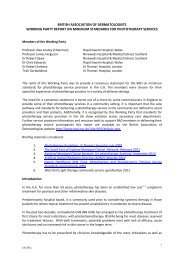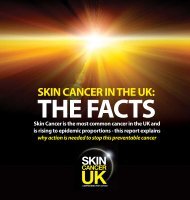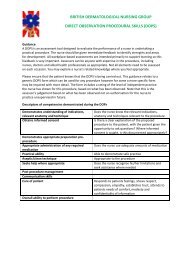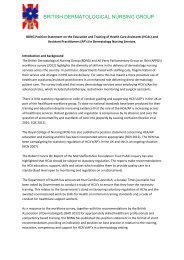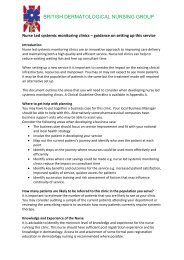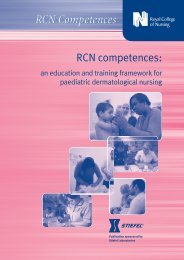Improving outcomes for people with skin tumours including melanoma
Improving outcomes for people with skin tumours including melanoma
Improving outcomes for people with skin tumours including melanoma
You also want an ePaper? Increase the reach of your titles
YUMPU automatically turns print PDFs into web optimized ePapers that Google loves.
<strong>Improving</strong> Outcomes <strong>for</strong><br />
People <strong>with</strong> Skin Tumours<br />
<strong>including</strong> Melanoma<br />
Management of special<br />
groups<br />
The SSMDT should have access to bone marrow aspirate and trephine<br />
biopsies <strong>for</strong> complete staging of all patients <strong>with</strong> B- and NK-cell<br />
lymphomas and <strong>for</strong> patients <strong>with</strong> CTCL variants and late stages of<br />
mycosis fungoides (stage IIb or above).<br />
The World Health Organization (WHO)–EORTC primary cutaneous<br />
lymphoma classification should be used to classify primary cutaneous<br />
lymphomas.<br />
Chemotherapy should be reserved <strong>for</strong> patients <strong>with</strong> advanced disease<br />
as it may have a detrimental effect on those <strong>with</strong> early disease.<br />
Skin sarcomas<br />
Skin cancer MDTs should liaise <strong>with</strong> sarcoma MDTs in the<br />
management of patients <strong>with</strong> cutaneous sarcomas. As stated in the<br />
section on SSMDTs, it is essential <strong>for</strong> all cutaneous sarcomas to<br />
receive specialist histopathology review. 61<br />
Sarcomas needing SSMDT review include all those involving the<br />
dermis and subcutaneous fat above the superficial fascia. It is<br />
appropriate <strong>for</strong> small/superficial cutaneous sarcomas to be dealt <strong>with</strong><br />
by the SSMDT.<br />
6<br />
It is essential that there is close liaison between the SSMDT and<br />
sarcoma MDTs. This is particularly important <strong>for</strong> patients whose<br />
sarcomas are large or penetrate the superficial fascia or are of a<br />
histological type requiring chemotherapy (e.g. rhabdomyosarcoma,<br />
Ewing’s sarcoma).<br />
Patients <strong>with</strong> KS should be referred to experts in the management of<br />
this tumour.<br />
Children and young <strong>people</strong><br />
All children and young <strong>people</strong> diagnosed <strong>with</strong> <strong>skin</strong> cancer should be<br />
managed <strong>with</strong>in the context of an MDT, which will include a<br />
dermatologist expert in <strong>skin</strong> malignancies and have access to<br />
specialist children and young <strong>people</strong> cancer support services and<br />
inpatient facilities at network level (see NICE service guidance<br />
<strong>Improving</strong> <strong>outcomes</strong> in children and young <strong>people</strong> <strong>with</strong> cancer 62 ).<br />
61 National Institute <strong>for</strong> Health and Clinical Excellence (Publication due March 2006)<br />
<strong>Improving</strong> <strong>outcomes</strong> in <strong>people</strong> <strong>with</strong> sarcoma. Available from: www.nice.org.uk<br />
62 National Institute <strong>for</strong> Health and Clinical Excellence (2005) <strong>Improving</strong> <strong>outcomes</strong> in<br />
children and young <strong>people</strong> <strong>with</strong> cancer. Available from: www.nice.org.uk<br />
120<br />
National Institute <strong>for</strong> Health and Clinical Excellence




